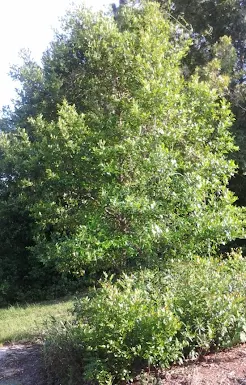Useful for : Shade, Xeriscaping, Wildlife Habitat. Native to : Coastal Southeast United States.
This beautiful evergreen native has a terrible reputation due to its prolific seeding and runners. The seeds germinate readily even in poor soil, which makes it simple to transplant the tiny trees into more desirable locations.
The full tree itself is a small tree or shrub, but can possibly get as high as 40 ft, though rarely does so when grown out in the open in full sun. The tree grows very well in sand and is very drought tolerant.
Every winter visiting robins from the north invade my trees to eat the big black berries (about the size of blueberries.) It is well documented that the leaves, stems, and seeds of cherry laurels are high in cyanide, which is toxic to all mammals, but very little information is available about whether the de-seeded fruit is edible or not. Birds eat it, but their metabolism might be able to handle some cyanide while ours cannot. We did taste a fruit, and it was sweet, but were too scared to eat it!
A great place to use this tree in a landscape is anywhere that you might enjoy seeing birds, such as outside a patio or kitchen window. It grows quickly so is good for fast shade around your home. It could be used to make a great big hedge which will widen and thicken over time, due to the runners.
We will keep looking for more information about the fruit being toxic. IFAS says that “the fruit is suitable for human consumption” and that squirrels eat it. We have never squirrels eating it, but that doesn’t mean that they won’t.
A green dye can be made from the leaves, and a dark gray to green dye can be made from the fruit.
